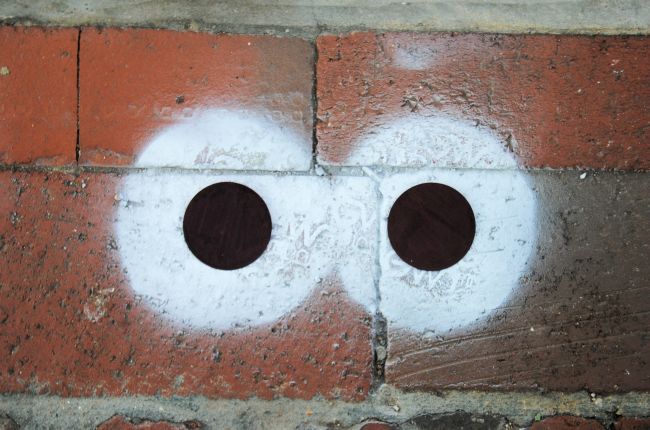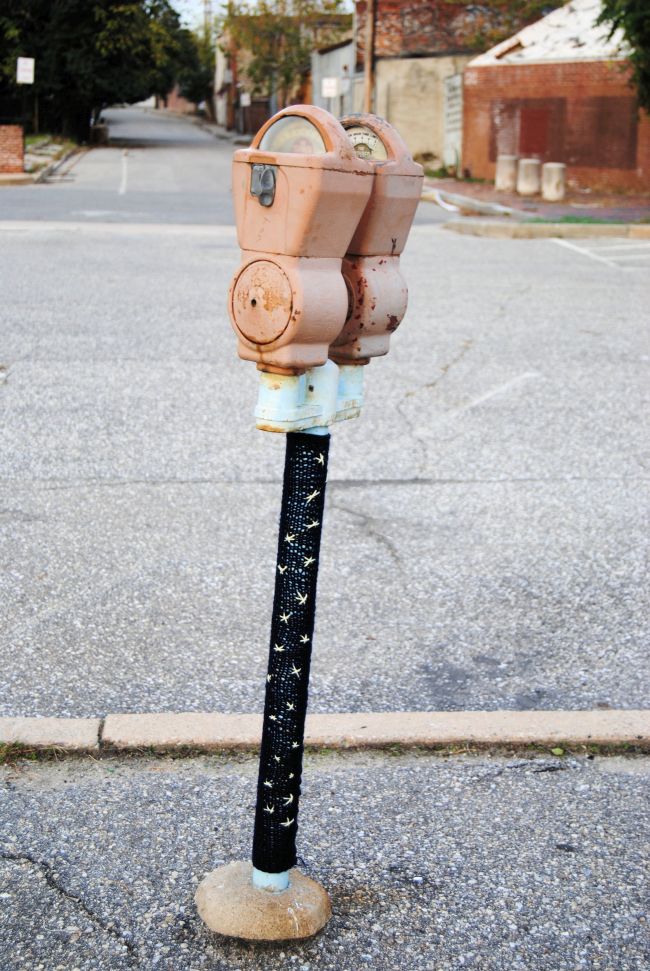People tend to have a lot of questions about guerrilla art, and it’s fair because it’s not something most people know a lot about. Today I want to give some insight into what I’ve learned about the scene over the past two and a half years.

There are a lot of different types of guerrilla art. Sometimes we call it “public art” or “street art”, but it’s all the same thing. If you are claiming public space back for yourself and your community, then we’re talking about the same thing. Murals, graffiti tags, yarnbombs, and sidewalk chalk installations are all guerrilla art. And if you’re going to go out on the town and paint it into a rainbow, there are a few things you should be aware of.
Understand that anything you’re doing can be considered illegal, unless you have explicit permission from the place you’re working at. At a base level, you could be charged with trespassing, littering, or the destruction of property. This is why I like to work with mediums that are mostly temporary, so if I were to ever be asked to stop by the police or another type of authority, it would be easy for me to inoffensively take it down and move on.
Sometimes, though, there are places in your city that are more or less designated for street art. There is an L shaped alley in Baltimore called “Graffiti Alley” that the police have basically decided it is legal to spray paint in. Do some internet searching for your town and see if there’s something similar.
There are also opportunities to get paid to do your art. Talk to people in the public art sect of city works or businesses who might commission you to make their buildings more beautiful.

Speaking of getting caught, know that this is an option. The entire time I’ve been doing this, I’ve never been stopped in a negative way. I tend to do my installations in the morning because things are less sketchy in the daylight. Act with confidence and it’s likely no one will think twice about what you’re doing. And most of the time, cops have more things to worry about than me wrapping yarn around a parking meter.
If you are asked to stop, then stop! You can always go somewhere else to do the same thing. And if there are cops on the scene when you get there, just wait for them to leave. Don’t give them a reason to have to interact with you.
Not everyone is going to like that you’re doing this. People might take your work down, or deface it. You might not come back to what you expected to see, and you have to accept that as soon as you walk away from a public work, it is a gift to the community. And not everyone is going to sit down and write you a thank you card. This does make the times that things work out even sweeter, though.
Lots of passersby are going to ask what you’re doing, though, just out of curiosity. It can be kind of daunting (and scary) to have to explain what you’re doing to dozens of people, so you can say things like: “It’s just for fun”, “Just adding a little color”, or “It just looked a little gloomy here!”

Make sure you bring any supplies you might need. Scissors, tape, glue, string, needles, business cards, extras. And bring a bag to keep everything in. What I like to do as soon as I’m done installing is hide all my supplies and take out my camera, that way, if someone who would hate what I did came by, I can just say I found this and am taking pictures. I’m no longer the artist, just a bystander.
Decide if you want to be anonymous or not. This doesn’t need to be a decision that goes across the board, mind you. There are some things that I always leave my card on and some things I prefer to do from an anonymous point of view. But you do need to figure out if it’s something you want your name attached to or not.
Guerrilla art does not need to be political. Many artists choose to make their installations a statement of some kind, but that doesn’t need to be the case. As Keri Smith says, “the medium itself is the political act”.
There are politics within the local scene, though. Artists can be kind of nasty to each other, and there becomes an air of competition and the fear of “snitching” on others to get yourself off if you’re caught. It can also be very taboo to do an installation on top of someone else’s work.
Scouting out your location, including potential measurements is highly beneficial. Start off in neighborhoods where you’re more likely to be appreciated. You’d know your town better than me. And never endanger yourself just to do an installation.
Really, just think about what attracts you to this as an art medium. Do you like to interact with strangers? Do you want to pass along good vibes to your community or give them something to enjoy and participate in? Figuring out what draws you to it will make it easier for you to get your foot in the door. Start with something you’re comfortable with and work up your confidence level.
If you want to get yourself a starter kit, I have some in my shop!
Mediums to consider:
![]() Stickering
Stickering
![]() Stencils
Stencils
![]() Flyers
Flyers
![]() Yarnbombing
Yarnbombing
![]() Interactive
Interactive
![]() Disposable Cameras
Disposable Cameras
![]() Murals
Murals
![]() Spray Paint
Spray Paint
![]() Guerrilla Gardening
Guerrilla Gardening
![]() Eyebombing
Eyebombing
![]() RAOKs
RAOKs
![]() Sidewalk Chalk
Sidewalk Chalk
![]() Performance Art
Performance Art
![]() Sculpture
Sculpture
![]() Snail Mail
Snail Mail
Some of my favorite guerrilla artists:
![]() Katie Sokoler
Katie Sokoler
![]() Candy Chang
Candy Chang
![]() Keri Smith
Keri Smith
![]() Luzinterruptus
Luzinterruptus
![]() Banksy
Banksy
![]() Olek
Olek
![]() Deadly Knitshade
Deadly Knitshade
![]() Improv Everywhere
Improv Everywhere
Resources to check out:
![]() The Guerilla Art Kit
The Guerilla Art Kit by Keri Smith
![]() Sneaky Art
Sneaky Art by Marthe Jocelyn
![]() Yarn Bombing
Yarn Bombing by Mandy Moore + Leanne Prain
![]() Craft Activism
Craft Activism by Joan Tapper
![]() On Guerrilla Gardening
On Guerrilla Gardening by Richard Reynolds










This made me really, really want to give this a try — I read through your stickering posts and I would never think to go get blank labels to draw on!
Thanks for the inspiration!
Nice! Yeah man, blank labels are a super easy and fun way to go. Lots of taggers actually use the “Priority Mail” labels from the post office to draw on things. It’s technically super illegal because it’s a misuse of federal property, but you can grab them by the handful at your local PO. I hope you do go out and sticker your town! Let me know if you post any photos!
I really, really like that sea of balloon animals! Your creation?
http://itsjpei.wordpress.com/
The balloons were actually made by my friend, April. I helped her add them to sticks and actually create the installation. You can check out the whole post here.
Thank you for this wonderful post, Mary! I just bought a copy of “Sneaky Art” thanks to your suggestion.
Nice!! You’re going to love it. We made things from the book’s tutorials at my art bomb party last year. Miniature cork people? So cool.
Love the Guerilla Gardening idea. Did this 3 years ago, going to do some more!
Yeah! Do it! Take pictures and send them to me.
Hi again, Mary! I just wanted to add that the 10th anniversary edition of Yarn Bombing by Leann Prain and Mandy Moore is coming out this month. Cheers!
Oh my gosh that’s so funny, I just picked this book up today randomly!!!